Firstly, the preparation phase: writing the speech
Choose the right style of language (open, rigorous or humorous) for each situation and improve the content of the speech.
Use humorous and realistic sentences to build up the emotion and make the speech more clear.
The speech must contain the following elements: an opening introduction, a brief biography, basic information about the speech (topic, length and relevant subheadings), introductory remarks, main content, remarks about interaction with the audience, interpretation of diagrams and concluding remarks, and so on.
Reasonable arrangement of the time of each part to ensure that the entire speech is controlled within 10 to 20 minutes.
Next is the production stage: designing the PPT
The background should be clean and clear, and it is recommended to choose more simple and light colours.
Long text needs to be broken down into several points, with clear images and tables.
Be sure to remove the watermarks from the images to ensure that they are of good quality and to improve viewing.
And finally, the presentation stage: making the presentation
Prior to the interview, adjust your mindset and present an emotional and rhythmic speech to enhance your impact.
Find suitable “actors” in advance to simulate the questioning scenario to avoid the embarrassment of no one asking questions.
Plan your standing position in advance to eliminate visual obstacles and problems facing the audience.
Rehearse several times and listen to your classmates’ opinions and suggestions.
Anticipate possible emergencies and make sure you have a strategy for dealing with them.
Focus on eye contact with the audience during the presentation and use gestures to enhance persuasion.
At the end of the presentation, mention the key points again to deepen the audience’s impression; politely express your thanks.




